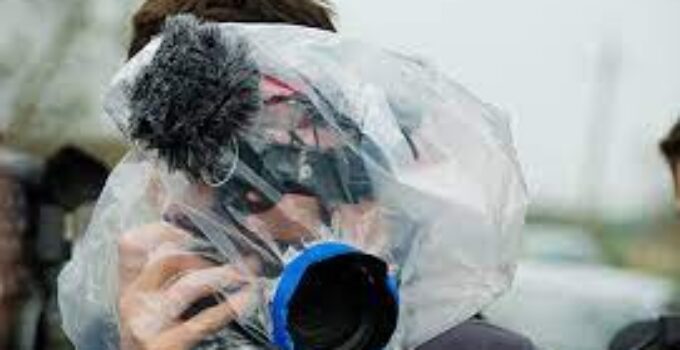Can a Ziploc bag protect your camera in the rain? This question often puzzles photographers who worry about their gear in unpredictable weather.
Is this simple solution effective enough to safeguard your expensive equipment?
A Ziploc bag can provide temporary protection for your camera from rain. However, it is not a foolproof solution and lacks the reliability of professional rain covers.
In this article, we’ll explore the effectiveness of Ziploc bags, alternative solutions, and tips from experts like renowned photographer Joe McNally.
Wondering if you can trust a Ziploc bag with your camera in a downpour?
Curious about better ways to shield your gear? Let’s dive into the details and find out how you can keep your camera safe and dry.
What is ziplock bag?
Ziplock bags are a type of resealable plastic bag with a zipper-like closure at the top.
They are commonly used for storing food, snacks, and various items to keep them fresh and prevent spillage.
The “zip” part of the name comes from the interlocking grooves or tracks on the bag’s opening that can be pressed together to seal the bag shut.
This design makes Ziplock bags convenient for everyday use, as they can be easily opened and closed multiple times without losing their effectiveness.
here how to make a camera bag for DSLR?
Ziplock bags come in various sizes, from small ones for storing snacks to larger ones for organizing items in drawers or keeping food items in the fridge or freezer.
Their versatility and reusability make them a popular choice for storage and organization purposes in homes, offices, and even during travel.
Are ziplock camera bag worth it?
The worth of a Ziplock camera bag depends on your needs and preferences.
They can be a budget-friendly option and offer some advantages such as being waterproof and providing basic protection against dust and scratches.

However, they may lack the padding and structural support that dedicated camera bags provide. If you’re on a tight budget or need a quick solution for occasional use, a Ziplock bag can be a reasonable choice.
On the other hand, dedicated camera bags are designed with padded compartments, customizable dividers, and additional features like straps and pockets for accessories.
They offer better protection for your camera gear, especially if you’re carrying expensive or delicate equipment regularly.
If you prioritize safety, organization, and convenience, investing in a quality camera bag might be more worthwhile in the long run.
Consider your usage frequency, equipment value, and desired level of protection when deciding between a Ziplock bag and a dedicated camera bag.
Here, how to make a insulated camera bag.
Why to use ziplock camera bag
Using a Ziplock camera bag can be a practical choice for several reasons:
- Cost-Effective: Ziplock bags are inexpensive and widely available, making them a budget-friendly option compared to dedicated camera bags.
- Waterproofing: Ziplock bags are generally waterproof, offering basic protection against moisture, rain, and accidental spills, which can be beneficial in outdoor or unpredictable weather conditions.
- Dust and Scratch Protection: They can help keep dust, dirt, and scratches away from your camera equipment, especially when storing or transporting them in less controlled environments.
- Versatility: Ziplock bags come in various sizes, so you can choose one that fits your camera and accessories snugly, providing a compact and portable storage solution.
- Temporary Solution: If you need a quick and temporary way to protect your camera gear, a Ziplock bag can serve the purpose until you invest in a dedicated camera bag.
While Ziplock bags lack the specialized padding and organizational features of dedicated camera bags, they can still offer basic protection and convenience for occasional use or when traveling light
Here, how to make a backpack camera bag?
Can a ziplock bag protect your camera in the rain?
7 Benefits of using ziplock bag in raining
How can I cover my camera when it’s raining?
To cover your camera when it’s raining, you have a few options:
- Use a Waterproof Camera Bag: Invest in a dedicated waterproof camera bag designed to provide complete protection against rain and moisture. These bags typically have sealed seams, waterproof zippers, and padded interiors to keep your camera dry and safe.
- Use a Rain Cover: Purchase a rain cover specifically designed for your camera model or a universal one that fits various camera sizes. These covers are made from waterproof materials and feature openings for the lens and viewfinder, allowing you to shoot while keeping your camera protected from raindrops.
- Use a Ziplock Bag: In a pinch, you can use a large Ziplock bag to cover your camera temporarily. Place your camera inside the bag, seal it tightly, and cut a hole for the lens to poke through. While not as effective as dedicated solutions, this method can provide basic protection in light rain.
Each option offers varying degrees of protection, so choose based on your needs and budget.
Here, does vera bradley make a camera bag?
Does a ziplock bag work as a waterproof case?
While a Ziplock bag can provide some level of water resistance, it is not designed to function as a fully waterproof case.
Ziplock bags are typically made of thin plastic with a zip-style closure, which may offer basic protection against splashes, light rain, or moisture. However, they are not airtight or sealed like dedicated waterproof cases.
Waterproof cases are specifically designed with robust materials and sealing mechanisms to keep water out completely, even when submerged or exposed to heavy rain.
They often have features like gaskets, O-rings, and secure latches to create a watertight seal around your device, ensuring maximum protection against water damage.
While a Ziplock bag can be a quick and temporary solution for protecting your camera or other items in light rain or damp conditions, it is not recommended for use in situations where complete waterproofing is necessary, such as underwater photography or during heavy rainfall.
How to keep rain off security camera lens?
Do ziplock bags prevent moisture?
Ziplock bags can provide some level of protection against moisture, but they are not entirely foolproof in preventing it.
The plastic material of Ziplock bags is generally waterproof, which means they can block water from entering the bag under normal conditions.
This makes them useful for storing items that need protection from spills or light exposure to moisture.
However, Ziplock bags may not be effective in highly humid environments or prolonged exposure to moisture.
Condensation can occur inside the bag, especially if there is a temperature difference between the inside and outside of the bag. This can lead to moisture buildup on the contents, including electronic devices like cameras or phones.
For critical moisture protection, such as for sensitive electronics or documents, it’s advisable to use dedicated moisture-proof containers or bags designed specifically for that purpose.
These containers often have additional features like desiccants or moisture-absorbing materials to keep the interior dry and free from moisture damage.
Here, does tumi makes a camera bag?
How ziplock bag protect your camera in the rain?
9 ways to cover your camera with ziplock bag
1. Simple Enclosure Method:
Place your camera inside a large Ziplock bag and seal it tightly. Press out excess air before sealing to create a snug fit around the camera.
While this method provides basic protection against dust and light moisture, it may not be sufficient for heavy rain or prolonged exposure to water.
2. Double Bagging Technique:
For added protection, use two Ziplock bags. Place your camera in one bag and seal it securely, then place the first bag inside a second Ziplock bag and seal both bags tightly.
This double layering can enhance water resistance and provide a more secure barrier against moisture.
3. Lens Extension Method:
To allow for lens extension while keeping the camera protected, cut a small hole in the bottom corner of the Ziplock bag. Insert the lens through this hole and secure the bag around the lens mount using a rubber band or tape.
This method enables you to extend the lens without exposing the camera body to rain or moisture.
4. DIY Lens Hood Cover:
Create a makeshift lens hood cover using a Ziplock bag.
Cut a square piece of the bag large enough to cover the lens hood. Secure it around the lens hood using tape or a rubber band. This setup helps prevent raindrops from directly hitting the lens and causing water droplets on your photos.
5. Securing with Velcro Strips:
Attach Velcro strips to the edges of a Ziplock bag and to the camera body.
Place the camera inside the bag and seal it shut. The Velcro strips provide a more secure closure and can be easily opened for quick access to the camera controls when needed.
6. Vacuum Sealing Technique:
For maximum protection against moisture and water, use a vacuum sealer with Ziplock bags.
Place your camera and accessories inside the bag, then use the vacuum sealer to remove air and create a tight seal. This method eliminates air pockets and ensures a waterproof barrier around your camera gear.
7. Customized Bag for Accessories:
Use smaller Ziplock bags to create compartments for camera accessories such as memory cards, batteries, and cables. Label each bag for easy identification and organization.
Place these smaller bags inside a larger Ziplock bag containing the camera for comprehensive protection and organization.
8. Tape Seal Method:
Seal the Ziplock bag with strong waterproof tape, such as duct tape or packing tape, for added security.
Apply the tape along the edges of the bag where it seals to reinforce the closure and prevent water from seeping in through the zipper.
9. Desiccant Pack Addition:
Include a desiccant pack inside the Ziplock bag to absorb any moisture that may accumulate inside.
Desiccant packs help maintain a dry environment within the bag, reducing the risk of condensation and potential water damage to your camera equipment.
Each of these methods offers varying degrees of protection and customization options based on your specific needs and the level of rain or moisture exposure expected during use.
Related faq’s
What do you guys use to protect your camera from the rain?
How do you protect the slates and ID the camera on rainy days?
To protect slates and identify cameras on rainy days, we employ several strategies:
- Waterproof Slates: We use slates made of waterproof materials or cover standard slates with waterproof sleeves to prevent water damage and ensure legibility of production information during rainy conditions.
- Waterproof Markers: We use waterproof markers or pens to write on slates and camera ID tags. These markers are designed to resist water, ensuring that information remains visible and intact even in wet weather.
- Plastic Covers: Cameras are often fitted with plastic covers or rain sleeves that shield them from rain while allowing for continued operation and visibility of camera settings and controls.
- Labeling and Tagging: Each camera is labeled with waterproof ID tags or stickers that include essential information such as camera model, serial number, and user details. These tags help identify cameras and track equipment during rainy shoots.
By implementing these measures, we ensure that slates and cameras remain protected and identifiable, maintaining efficiency and organization even in challenging weather conditions.
Is a camera bag enough to avoid condensation?
While a camera bag provides some protection against external factors like dust, moisture, and minor impacts, it may not be sufficient to prevent condensation entirely.
Condensation occurs when warm, moist air comes into contact with a cooler surface, leading to water droplets forming on that surface.
Inside a camera bag, especially if the environment is humid or there are temperature changes, condensation can still occur.
To minimize condensation inside a camera bag, it’s important to:
- Use silica gel packets or desiccants to absorb moisture.
- Allow the camera and accessories to acclimate to the ambient temperature before placing them in the bag.
- Avoid sealing the bag completely if the equipment is warm to allow for air circulation.
- Use a bag with breathable materials or ventilation openings to regulate humidity.
Ultimately, while a camera bag helps protect against many environmental factors, additional measures may be necessary to prevent condensation buildup effectively.
Conclusion:
Using a Ziplock bag to protect your camera in the rain can provide a basic level of protection. However, it’s not a foolproof solution and may not withstand heavy rain or prolonged exposure.
For better protection, consider investing in a dedicated camera rain cover or waterproof case








